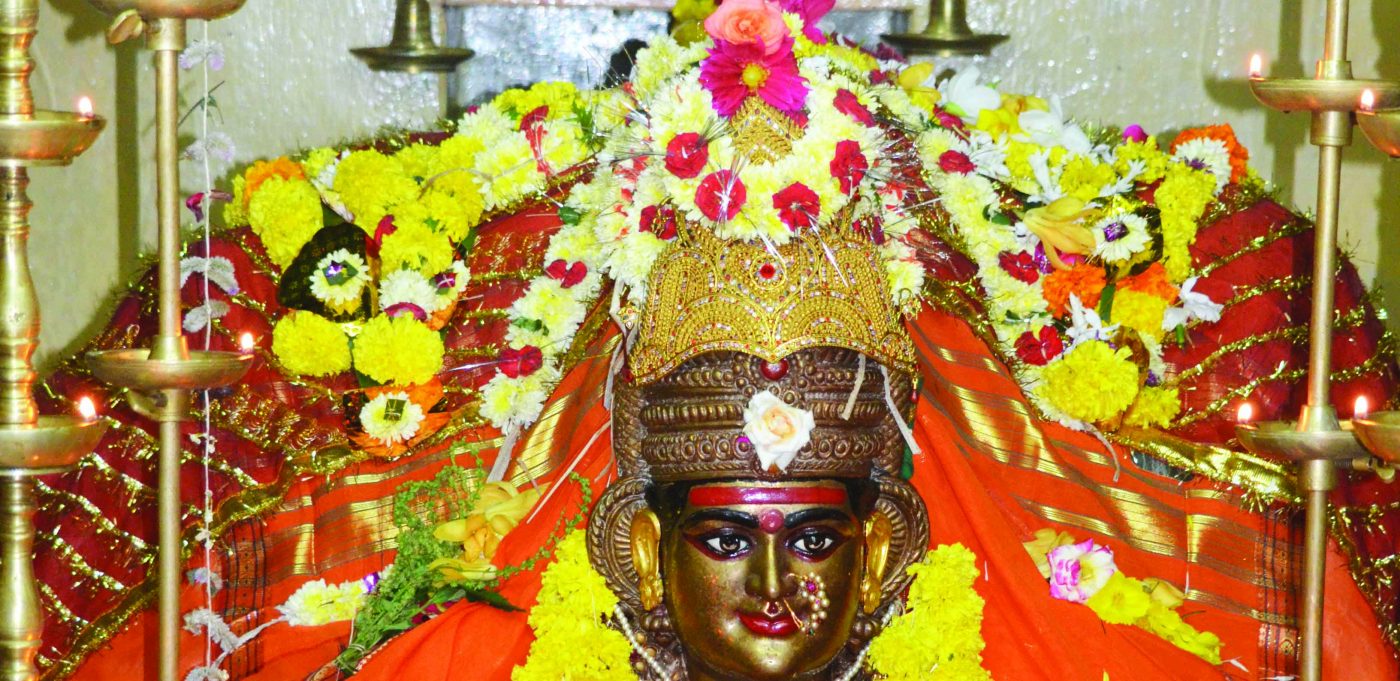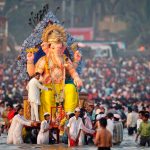RAJENDRA P. KERKAR
Throughout Goa, from Pernem to Canacona, the cult of Sateri worship is dominating. However, Sattari taluka has a large number of Sateri temples. There are also the sacred groves wherein the forest cover along with the biological wealth has been given protection by the local community. Some of these sacred forests contain the stone sculptures of the goddess Santer in the forms of Mahishasurmardini.
The land of Goa since time immemorial has the rich and varied tradition of Santer worship, aniconically in the form of an ant-hill and iconically during the later period in the form of Mahishasurmardini. This is the most popular goddess of the Goan community, irrespective of the caste or tribe, and is worshipped from the pre-Portuguese period and has reference in the old folksongs. The eco-feministic festival of ‘Dhalo’ that is celebrated during the Paush, the tenth month of the lunar calendar, and ‘Dhillo’ which is celebrated during the Ashwin-Kartik, the seventh and eighth month, has the melodious songs in the honour of the goddess Santer.
In Goa, Santer was once worshipped widely in the form of ant-hill, locally known as ‘roen’. This ant-hill is also worshipped as Bhumka, Mauli and Shantadurga whereas the iconic form of Mahishasurmardini is worshipped as Vitthala devi and Pavanai in various parts of Goa.
From the hoary past, people living in Goa and Konkan worshipped different aspects of the nature like soil, water, air, plants and animals. The Indian tradition worships the feminine form of Shakti in various other forms. The agricultural communities living in different parts of country began displaying love and affection for the fertility power possessed by the women as well as the earth.
Through agricultural activities, people realised that the earth is generous in giving bountiful food grains for their livelihood and this might be the reason accounted for establishing the tradition of mother goddess worship.
The ant-hill symbolically represents mother earth as it is made up of clay particles. The tradition of ant-hill worship is prevalent for many years on the West coast of India. Ecotheological roots of many religious beliefs can be traced to human proto-historic and pre-historic lifestyles.
If most of the rituals and practices related to the ant-hill, worshipped as goddess Sateri or Santer, are examined through the angle of eco-theology, we would be able to identify many relations to cycles of nature. Through the ant-hill worship, our ancestors have expressed their respect for the creative powers of earth. People living in Goa and Konkan, in tune with nature, have known earth’s creative, fertile and ecologically magical powers, due to which they respect the ant-hill as the living entity.
Earlier, most of the temples in Goa were worshipping goddess Santer in the form of ant-hill. However, when Goans were influenced by the worship of stone sculpture of goddess Mahishasurmardini, they preferred to worship the stone sculpture instead of ant-hill.
Goddesses such as Ela, Parvati, Mahamaya, Kamakshi, Navdurga, Vijaydurga are worshipped in the forms of stone sculpture as Mahishasurmardini. The earliest worship of Mahishasurmardini has been found in Lamgao village of Bicholim taluka. In this sculpture, the goddess is shown without a crown. She is shown wearing ear-rings, necklace and bracelets. She is holding a trident in the upper right hand and in the lower right hand she holds a sword. The left hand is on the back of the buffalo and in the other hand, which is broken, she is holding a bell. According to the archaeologist and historian, Dr. V. R. Mitragotri, this Mahishasurmardini has early Chalukyas characteristics and belongs to C. 600 A.D.
There are stone sculptures of Mahishasurmardini, discovered in Sattari, depicted on the boat. These unique sculptures are worshipped by the devotees as Santer or Shantadurga and throws light on the aspect of goddess taking devotees across the difficult ocean of existence and also on the navigability of the river Mhadei in the hoary past.
During the nine nights of this festival, celebrated as Ashwin Navratri, the devotees observe different rituals. On the tenth day, which is on the day of Vijayadashami, the marriage ceremony between the insignias (tarangas) of Santer as the consort of Ravalnath takes place. This ritual known as ‘Shivlagna’ indicates union of male entity with the female for facilitating the procreation.
Throughout Goa, from Pernem to Canacona, the cult of Sateri worship is dominating. However, Sattari taluka has a large number of Sateri temples. There are also the sacred groves wherein the forest cover along with the biological wealth has been given protection by the local community. Some of these sacred forests contain the stone sculptures of the goddess Santer in the forms of Mahishasurmardini.
The sacred grove of Taide in Tambdi Surla has the biggest sculpture of goddess Santer in Goa. Goa’s tribals and non-tribals as well as the communities belonging to higher castes are considering Santer as their family and village deity. Worship of Santer in the form of ant-hill signifies the respect for mother earth. Today, by worshipping Santer, the Goan culture has successfully woven a tapestry of Vedic and Dravidian, tribal and non-tribal, pastoral and agrarian threads, and has been deriving blessings of the mother earth.



























